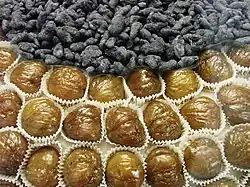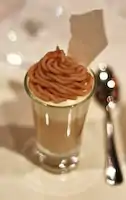 | |
| Type | Confectionery |
|---|---|
| Place of origin | Southern France |
| Region or state | Rhône-Alpes |
| Main ingredients | Chestnuts, sugar |
A marron glacé (plural marrons glacés) is a confection, originating in France[1][2] consisting of a chestnut candied in sugar syrup and glazed. Marrons glacés are an ingredient in many desserts and are also eaten on their own.
History
Candied chestnuts appeared in chestnut-growing areas in Europe shortly after the crusaders returned from the Middle East with sugar. Cooking with sugar allowed creation of new confectioneries.[3] But marrons glacés as such (with the last touch of 'glazing'), may have been created only in the 16th century.[4]
In 1667, François Pierre La Varenne, ten years' chef de cuisine to Nicolas Chalon du Blé, Marquis of Uxelles (near Lyon and a chestnut-producing area), and foremost figure of the nouvelle cuisine movement of the time, published his best-selling book Le parfaict confiturier. In it he describes "la façon de faire marron pour tirer au sec" ("the way to make (a) chestnut (so as) to 'pull it dry'"); this may well be the first record of the recipe for marrons glacés.[5] "Tirer au sec" means, in a confectionery context, "to remove (what's being candied) from the syrup". La Varenne's book was edited thirty times over seventy-five years.
Nevertheless, that book was not mentioned (nor indeed any other) when the recipe, applied to cocoa beans, was in 1694 passed on to Jean-Baptiste Labat, a French missionary in Martinique. That year he wrote in a letter of a recipe for candied and iced cocoa beans which he had tasted when dining at a M. Pocquet's.[6] Another early citation, still in French, is from 1690.[7]
Towards the end of the 19th century, Lyon was suffering from the collapse of the textile market, notably silk. In the midst of this crisis, Clément Faugier, a bridge and roadworks engineer, was looking for a way to revitalize the regional economy. In 1882, in Privas, Ardèche, he and a local confectioner set up the first factory with the technology to produce marrons glacés industrially (though many of the nearly twenty steps necessary from harvest to finished product are still performed manually). Three years later, he introduced the crème de marrons de l'Ardèche, a sweetened chestnut purée made from marrons glacés broken during the production process, flavoured with vanilla.[5][8] (later came Marrons au Cognac in 1924, Purée de Marrons Nature in 1934, Marrons au Naturel in 1951, and Marpom's in 1994.)[9]
The same process was used in 1980 by José Posada in Ourense, Spain. He was the first businessman to build a factory to produce Spanish marrons glacés using Galician raw chestnuts,[10][11] which previously were exported to France to produce the confectionery. Posada used the French formula to produce the marrons glacés. Today, there are two factories that produce marrons glacés in Spain.
Châtaigne or marron
The French refer to chestnuts as châtaigne or marron. Both terms refer to the fruit of the sweet chestnut Castanea sativa. However, marron tends to denote a higher quality, larger fruit that is more easily peeled.[12] The fifth edition of the dictionary Dictionnaire de l'Académie française. Revu, corrigé et augmenté published in 1798 states that a marron glacé is a confit marron that is covered in caramel.[13] The 1767 book L'agronome, ou dictionnaire portatif du cultivateur claimed that the best marrons came from the Dauphiné region in southeastern France, and contained instructions for preparing marron glacés.[14]
Chestnuts are covered with a membrane, known as a pellicle or episperm, which closely adheres to the fruit's flesh and must be removed because of its astringency. Marron nuts have a pellicle which is "superficially attached to the nut", making it easily removable from the fruit.[12] Some chestnuts have two cotyledons usually separated with deep grooves penetrating nearly all the way through the fruit; this makes them too fragile for the necessary manipulations during the cooking process. There also are other grooves on the surface, which means more embedded pellicle that must be painstakingly removed. "Marron"-quality nuts do not have the separation into two cotyledons; it appears in one piece and it shows few very shallow grooves.
In Italy, the term marrone denotes a specific high-quality cultivar of Castanea sativa bearing oblong fruits with a shiny, reddish epicarp and often exhibiting a small rectangular hilar scar.[12] As with the French use of the term, there should be no division of the cotyledons.[12]
Marron-quality nuts for marrons glacés may be three or four times more expensive than the châtaigne because they also have a lower yield[15] as the husk usually contains only one or two nuts and the plants have sterile male flowers.[12]
Uses

Marrons glacés may be eaten on their own.
Crème de marrons are a staple ingredient for other desserts, such as the Mont Blanc (puréed with cream), ice creams, cakes, sweet sauce or garnish for other desserts.
Cultural references
In the short story Reginald (1901) by Saki, the narrator leaves Reginald "near a seductive dish of marrons glacés" at a garden-party in the vain hope that these delicacies will distract him from wreaking social havoc.
In the Overture to Swann's Way, Marcel Proust refers to M. Swann bringing to Marcel's great-aunt on New Year's Day a little packet of marrons glacés.
In Patrick Skene Catling's children's book, The Chocolate Touch, marrons glacés are among the candies listed as the sweet-toothed young protagonist's favourite confectionery delights.
In the 1899 novel The Awakening by Kate Chopin, on a comfortable night as Edna Pontellier dines alone, she describes marrons glacé as "just what she wanted".
In the 1936 film Camille, Greta Garbo's character asks for "sweets", and Robert Taylor's character goes to some trouble to find fresh marrons glacés for her.
In the British television drama series Victoria, Queen Victoria played by Jenna Coleman repeatedly calls marrons glacés her "favourite".
In the 2021 Wes Anderson film The French Dispatch, Adrien Brody's character uses marrons glacés to bribe the prison guard for access to Benicio del Toro's character in prison.
In the 1971 novel Nemesis by Agatha Christie, Miss Marple describes marrons glacés as "an expensive taste which [she] cannot often gratify".
Local variants
Turkey
Candied chestnuts are a speciality of Bursa, Turkey, where they are called kestane şekeri (chestnut candy).[16]
See also
 Media related to Marron glacé at Wikimedia Commons
Media related to Marron glacé at Wikimedia Commons- Lyonnaise cuisine
Notes
- ↑ "History and production of marrons glacés". Gambero Rosso International. 10 October 2022. Retrieved 14 July 2023.
- ↑ Davidson, Alan (21 August 2014). The Oxford Companion to Food. OUP Oxford. ISBN 978-0-19-104072-6.
- ↑ Vegetarians in Paradise.
- ↑ "Taccuini Storici". Taccuinistorici.it. Retrieved 26 April 2011.
- 1 2 "Un peu d'histoire". Clément Faugier.
- ↑ Labat, Jean-Baptiste (1694). "Nouveau Voyage aux Isles françaises de l'Amérique". A very detailed letter about an adaptation of the recipe, also with glaze, applied on cocoa beans.
- ↑ Oxford English Dictionary, s.v. marron glacé
- ↑ Grieve, M. (1931). "Chestnut, sweet". A Modern Herbal.
- ↑ "Le Marron glacé de Privas, le meilleur de la chataîgne". Linternaute.com. 6 September 2005. Retrieved 26 April 2011.
- ↑ "El 'rey del marron glacé' ha contribuido a que la castaña de Galicia sea un producto gastronómico de primera categoría en Europa". ElPais.com. 15 November 1983.
- ↑ "José Posada, el patriarca gallego del 'marron glacé'". ElPais.com. 15 January 2013.
- 1 2 3 4 5 "Chestnut or marron". Inventory of chestnut research, germplasm and references. Food and Agricultural Organization of the United Nations, Interregional Cooperative Research Network on Nuts. Retrieved 11 September 2014.
- ↑ Dictionnaire de l'Académie françoise. Revu, corrigé et augmenté. Vol. 2 (5th ed.). Académie française. 1798.
- ↑ L'agronome, ou dictionnaire portatif du cultivateur. Vol. 2. Paris: Savoye. 1767.
- ↑ Fauve-Chamoux, Antoinette. "Chestnuts". In Kipple, Kenneth F.; Ornelas, Kriemhild Connee (eds.). The Cambridge World History of Food. Vol. 1. Cambridge University Press. pp. 359–364. doi:10.1017/CHOL9780521402149.036.
- ↑ Taviloglu, Elizabeth. "Candied Chestnuts Are A Classic Turkish Confection". turkishfood.about.com. Archived from the original on 5 October 2015. Retrieved 22 December 2013.